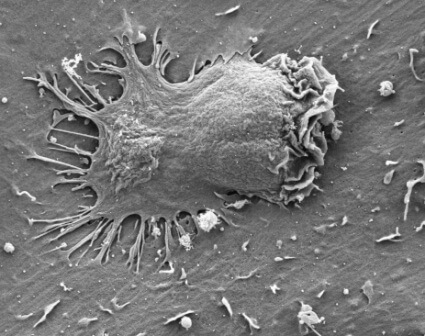Weizmann Institute scientists have shown how the cells lining the walls of blood vessels may act as a sort of "janitor" that hides certain chemical signals in a place where only "trained" immune cells can find them.

The white blood cells - those immune cells that fight invaders and diseases - navigate their way out of the bloodstream towards sites of inflammation or injury using "exit signs" - chemical signals that mark the place of passage through the walls of blood vessels to the inflamed tissue below. A new study by Weizmann Institute scientists, recently published in the online version of the scientific journal Immunology Nature, shows how the cells that line the walls of blood vessels may act as a kind of "janitors" that hide certain chemical signals in a place where only "trained" immune cells can find them.
In previous studies, Prof. Ronan Alon and members of his research group from the Department of Immunology discovered that the white blood cells crawl quickly on the inner wall of blood vessels using dozens of small legs. These legs have a strong grip on the surface, and they also recognize the "exit signs". The traffic signs are actually molecules called chemokines, which are created in the tissue and in the endothelial cells that line the blood vessels, and are "displayed" on the surface of the walls of these cells.
In the current study, conducted by research student Dr. Ziv Shulman and postdoctoral researcher Dr. Shmuel Cohen, it was discovered that some of the chemokines produced in the endothelial cells are not displayed on their surface. The scientists followed the recruitment of a certain group of immune cells called "effector cells". This is one of the "special units" of the immune system: it receives its training in the lymph nodes, where it learns to identify disease-causing agents (pathogens), and then it returns to the bloodstream to find these pathogens and destroy them. Like all white blood cells, the effector cells also crawled using small legs on the wall of blood vessels in the area of pathogen penetration, but instead of sensing chemokines on the surface, they threaded their legs into the endothelial cells, to search and find the chemokines inside. The internal chemokines are held within tiny vesicles within the walls of the inflamed endothelial cells. The effector cells stopped at junctions between the cells, and inserted their feet through the walls of several endothelial cells at once, to capture the chemokines as soon as they were released from the vesicles near the cell membranes. Once they received the correct chemokine messages, the immune cells were able to cross the blood vessel wall towards their final destination in the inflamed tissue.
The scientists believe that keeping the chemokines inside the endothelial cells ensures, on the one hand, protection of these vital signals from being washed into the bloodstream and from being broken down by various enzymes, and on the other hand, it ensures that only effector cells that have undergone the special training in the lymph nodes, and are able to find the signals, will cross Successfully penetrate the inflamed blood vessel wall, and reach the damaged tissue.
Prof. Alon: "The findings show that the endothelial cells are much more than a sticky barrier of the blood vessel walls. These cells actively choose which of the immune cells will cross the barrier, and which will not. Endothelial cells appear to play an active role in directing immune cells in the direction of egress by expressing certain chemokines, but we still do not know how they do this. In addition, we hypothesize that cancerous tumors located near blood vessels may misuse these rules of movement: they may put the endothelial cells into a quiescent state, in which they express a small amount of 'exit signals', or cause them to produce 'wrong' chemokines, so that cells Immune cells capable of destroying the tumor will not pass, while cells that help the cancer grow will pass through the endothelial cells."
